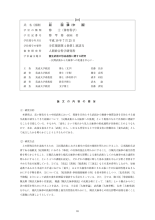17 0 0 0 OA 養生武術の形成過程に関する研究 : 民間武術から太極拳への変遷を中心に
- 著者
- 屈 国鋒
- 巻号頁・発行日
- 2007
筑波大学博士 (体育科学) 学位論文・平成19年7月25日授与 (甲第4494号)
5 0 0 0 OA 楊氏太極拳に関する研究―陳氏拳法から楊氏太極拳への変遷について―
- 著者
- 屈 国鋒 藤堂 良明 酒井 利信
- 出版者
- 日本武道学会
- 雑誌
- 武道学研究 (ISSN:02879700)
- 巻号頁・発行日
- vol.40, no.1, pp.27-38, 2007-07-31 (Released:2012-11-27)
- 参考文献数
- 43
This study aims to clarify the transition process from Chenshi Quanfa to Yangshi Taichi. In examining the transition process, we considered the following four questions.1. Why did the change from actual fighting to the concept of improving health and fitness occur in the minds of these two martial arts leaders?2. Did Yang try to establish Taichi with the purpose of improving health in mind from the very beginning?3. Why did Yang, who was an excellent fighter himself, make his Quanfa known as a health management method?4. What specific changes occurred over the three Yangshi generations?The answer to the first question is thought to lie in differences in social conditions, geographical factors, and the purpose of instruction. The same is true of the third question.As to the answer to the second question, we found that Yang Luchan initially tried to publicize his Taichi as an actual fighting martial art rather than designating it as a method of improving health and fitness.Based on the above analysis, we can summarize the transition process from Chenshi Quanfa to Yangshi Taichi as follows. Chenshi Quanfa, which was characterized both as an actual fighting technique and for improving health, was exported to the world outside Chen Jia Gou through the efforts of Yang Luchan. Yang Luchan and Yang Banhou lived in turbulent times, and they initially contributed much to the character of the actual fighting that featured Chenshi Quanfa. As they developed Chenshi Quanfa, however, they increasingly emphasized its usefulness for improving health to cope with social conditions, geographical factors, and differences in instruction methods. Yang Chengfu, who was Yang Luchan's grandson, established the current Yangshi Taichi, which focuses on the concept of improving health and fitness. It is the writer's belief that this process is the answer to the fourth question.
